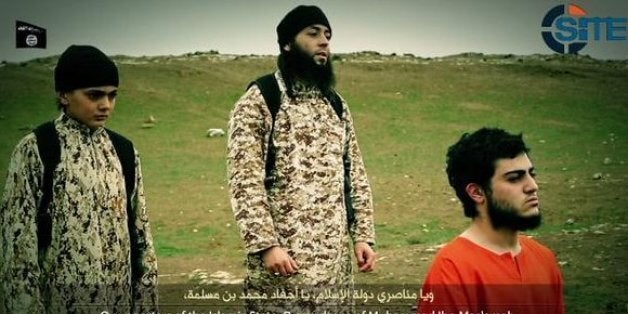
In a shocking video released by ISIS's media outlet Furqan on March 10, a young boy appears to shoot and kill a Palestinian prisoner accused of being a spy for the Israeli intelligence agency Mossad.
The video resembled one released by ISIS in January that featured a Kazakh boy seemingly executing two Russians also accused of being spies.
The videos reflect two emerging trends. The first is the increasing role played by very young children on the front lines of ISIS. ISIS has released several videos of its Camp Farouk military training facility in Raqqa in which children ("cubs of the caliphate") are being prepared to be the next generation of fighters. But their recent child execution videos imply that children may be used much sooner than previously assumed.
"Terrorist groups try to ensure their survival by preparing the next generation."
The second trend is the multi-generational and familial aspect of radicalization and violence. Although it is unlikely that a child can be radicalized or that they can hold political beliefs that they genuinely understand, it is plausible that children can be brainwashed by adults who hold such beliefs. This takes the terrorist use of children to the next level. While we have observed that terrorist groups are rife with sibling co-conspirators (for example, the Tsarnaev and Kouachi brothers and the Price and Berayeva sisters), the evolution from father to son at such a young age verges on child abuse.
Further, the threat of imitation by children is indicative of this environment. The children in Raqqa act out what they see the adults doing. At ISIS training camps, children are reportedly told to practice beheadings on blond, blue-eyed dolls dressed in orange jumpsuits (like those worn by beheading victims James Foley and Steven Sotloff). And this imitation does not require witnessing massacres first-hand in Syria. Egyptian children have been posting videos on social media in which they carry out mock executions, ISIS-style, based on what they see on the news.
The literature has rendered child soldiers (in Africa and Latin America) and children's involvement in terrorism as more or less synonymous. Yet a preliminary examination suggests some significant differences between the two -- especially at the level of mobilization and the role played by parents, teachers and the community. Recruiting child soldiers involves explicit coercion such as kidnapping, armed force and the use of narcotics. In contrast, grooming for terrorist organizations usually appears to be a gradual process orchestrated to give the impression that the participation by children is, in fact, consensual.
"ISIS has been operating from the pedophile's playbook."
Terrorist organizations have historically indoctrinated children at an early age. Many groups in the Middle East, Europe and North America set up children's movements to ensure the longevity of the group. Studies conducted by Seth Jones and Martin Libiki (2008) have shown that all terrorist groups end in one way or another, and David Rapaport argues that the vast majority of terrorist groups do not survive beyond their first two years. For this reason, terrorist groups try to ensure their survival by preparing the next generation.
Terrorist organizations have established youth wings, training camps and propaganda targeting young children. Most terrorist groups engage the children in supporting roles until they are "old enough" for the front line. Youth wings exist in Northern Ireland (Ogra Sinn Fein), Lebanon (Hezbollah summer camps) and Sri Lanka (the Bakut Wing of the Liberation Tigers of Tamil Eelam). In each of the cases, the groups insisted that they had a minimum age requirement to participate in frontline activities (killing). Whether they always adhered to their own rules varied enormously from group to group but few embraced the idea of children as killing machines.
In most terrorist groups, children start as lookouts, messengers or weapon messengers and graduate through the levels of the organization. ISIS has preempted this process by activating children while they are still very young and putting them on the front lines before they complete their "apprenticeships as terrorists in training."
"At ISIS training camps, children are reportedly told to practice beheadings on blond, blue-eyed dolls dressed in orange jumpsuits."
The dominant narrative among child soldiers is that they have been orphaned -- often by the group that subsequently takes them in and "adopts" them. In contrast, in the case of ISIS, family units are commonly intact, as many men who join take their families along with them. Some parents are also knowingly encouraging their children to become involved with ISIS.
ISIS has been operating from the pedophile's playbook. Over a few weeks or months, they gradually expose children to behavior that is aberrant or at minimum, not especially child-like. With pedophiles, physical contact may begin with casual touching, leading to more and more aggressive contact over time and eventually rape. Pedophiles will expose children to pornographic materials, to desensitize them and lull them into sexual behavior. ISIS has done virtually the same thing with violence. The children watch beheading videos and are made to watch the beheadings in person. It has only been a small leap to see children engaged in an execution.
Not only are children being targeted for recruitment -- they are likewise being targeted for death. According to Jessica Stern and J.M. Berger's book ISIS: The State of Terror, children are being used as human shields or forced to give blood. A 2013 report by the Oxford Research Group found that over 11,000 children had been killed in the first two years of the Syrian conflict. The highest rate was reported in Aleppo where over 2,000 children were killed. Many of the deaths and injuries sustained by the children were the result of shelling and barrel bombs.
"Not only are children being targeted for recruitment -- they are likewise being targeted for death."
However, nearly 400 children died at the hands of pro-regime snipers. Unlike the collateral damage from aerial bombardment, sniping is not a random act and the children were specifically targeted. Sniping is a form of intimate killing, and one of the most deliberate acts any soldier can make -- depicted by Clint Eastwood's big-screen portrayal of Chris Kyle, in "American Sniper." Syrian children are deliberately being targeted as part of this conflict by multiple sides.
The long-term psychological sequelae for these children is unknowable. Children exposed to extreme violence at an early age suffer a host of problems as they grow up, from attachment disorders to the inability to show empathy or love to psychopathy. Former child soldiers in Africa suffering from such problems often undergo DDRR programs [Disarmament, demobilization, rehabilitation and reintegration], which use a combination of psychosocial approaches and vocational training.
However, for this approach to work with ISIS, these children need to be separated from a community that upholds perverse values that placed them in harm's way. Until that happens, there is no escaping the reality of the Islamic State that distorts right from wrong and good from evil.

